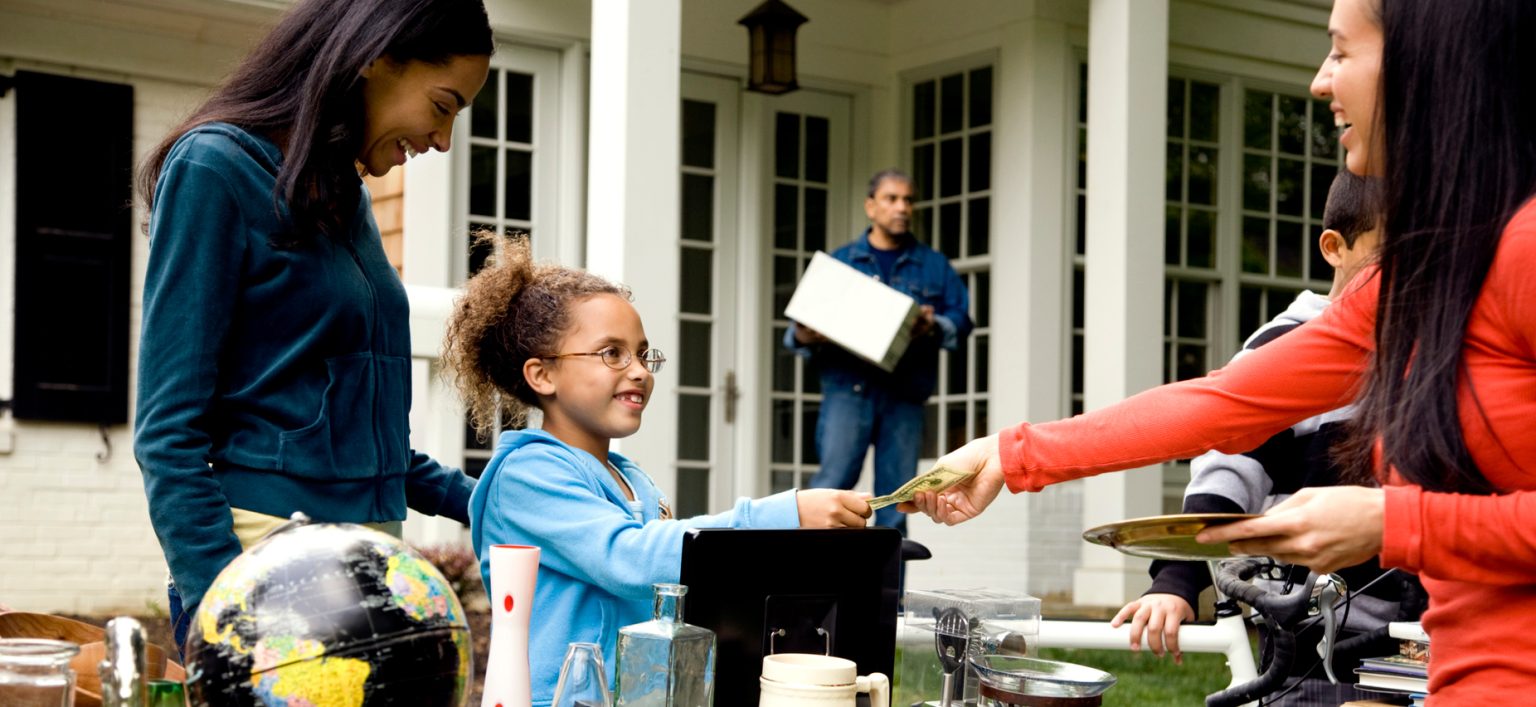A baby’s journey through childhood leaves a lasting impression. He also leaves behind mounds of outgrown clothes and accessories. Some people save everything, hoping to reuse the items for subsequent children, but eventually it all has to go. If you have a basement full of stuff that can only be used with a time machine, a yard sale may be in your future.
There are very simple rules to follow to ensure a successful sale, and they fall into the categories of: scheduling, time, organization and presentation. Investing a few dollars will also increase the odds for a profitable clean-out.
Selecting the Date
First, pick a date. Typically, you want to avoid having yard sales on holiday weekends. They aren’t successful unless you receive heavy traffic from vacationers. Run ads a week or two beforehand. Choose whatever media you’re comfortable with such as Craigslist, Facebook or the newspaper.
Don’t forget signs at busy intersections and at the ends of your road. Increase foot traffic by inviting neighbors to participate in a block sale.
Highlight a theme to attract the right customers (baby items vs. antique furniture). In my experience, Fridays and Saturdays are the best days; fewer people come on Sundays. And say “no early birds” if you don’t want people showing up at 6 a.m. while you’re still in your pajamas.
Putting in Time
Most people underestimate the amount of time it takes to pull together a good sale. I consider that time an investment. As with anything, diligence pays off. No one, especially busy parents of young children, has time to paw through a cardboard box full of random clothes.
Take a few evenings after dinner or on a weekend to go through each room, bin or closet to see exactly what stays and what goes.
Think seasonally. The winter gear that’s just been shed may not fit the little one next fall, so don’t hang on to it. Still not sure? If it hasn’t been used in over a year, it’s probably safe to sell.
Bundling is important to maximize a sale and clear space (more on that later), so choose items that are in good condition. Some kitchen items we pulled were wedding gifts we never used. I needed a few weeks on the clothes alone even though they were separated into totes for newborn, 12 to 24 months, and 2T-3T. The more diverse the items advertised, the more potential buyers, so check those boxes in the attic or garage, too.
Organize, Organize!
Ah, my favorite. Think like a department store, and keep similar things together: Housewares, Toys, Bedding.
Baby toys and baby clothes are often top sellers because they are used briefly and outgrown in very good condition. These need to be broken down further and separated.
Imagine a mom of a 12-month-old daughter seeing everything you have for that child on one rack as opposed to her having to circle a picnic blanket, table or box looking for that size.
Allow her to see not just one item but all of them. Use black markers on signs to identify and state the cost. It’s OK to have groups of items for the same amount with one price, and it eliminates unnecessary marking. Customers who know this up front are able to browse in their price range.
Don’t forget to go to the bank to get lots of small bills and change!
If the sale is large, be sure to have a few extra people available. Helpers can deter dishonest people from pocketing goods. We invite a favorite aunt or cousin to keep us company and help out.
Playing some good music and springing for doughnuts and coffee doesn’t hurt. If your helpers have items to sell, simply put their initials on the price stickers to keep the proceeds separate. Keep the cash box tucked away from visitors. Wearing an over-the-shoulder bag with the money inside is safer.
Include the immediate family in this event and encourage school-aged children to have a lemonade stand. They can learn firsthand about marketing and management.
The Right Look
Yard sales that are neat and clean, with reasonable prices, are profitable. If a garage is used for part of the sale, set up as much as possible the night before. Use plain, colored plastic cloths to keep the attention on your wares. Large or brightly colored items closest to the road attract drivers’ attention.
Here is where bundling pays off. Maximize a sale by putting outfits together if possible; then use a clothing rack or improvise for something similar and mark each size with a separator. If a buyer can’t see it, she won’t know she can’t live without it.
The goal is to have nothing left to bring back inside, so spend a little money on a couple dozen plastic hangers and package of safety pins. Baby clothes are the easiest to assemble since most are complete outfits. Include bonnets with sundresses and ball caps and jackets with denim.
Put loose items, such as socks, hair accessories or tights together in baggies and discount them. We put all small crib toys in a box with a general price of 50 cents each or three for $1. Be open to hagglers. A shopper offered a larger bill for the whole box, and we happily took it.
As you sell items, reorganize so everything appears fresh and orderly. Lower prices if items aren’t moving. Make prices rock bottom if they are not destined to return to the house – but please consider donating gently used items to local charity stores instead of pushing leftovers to the curb.





